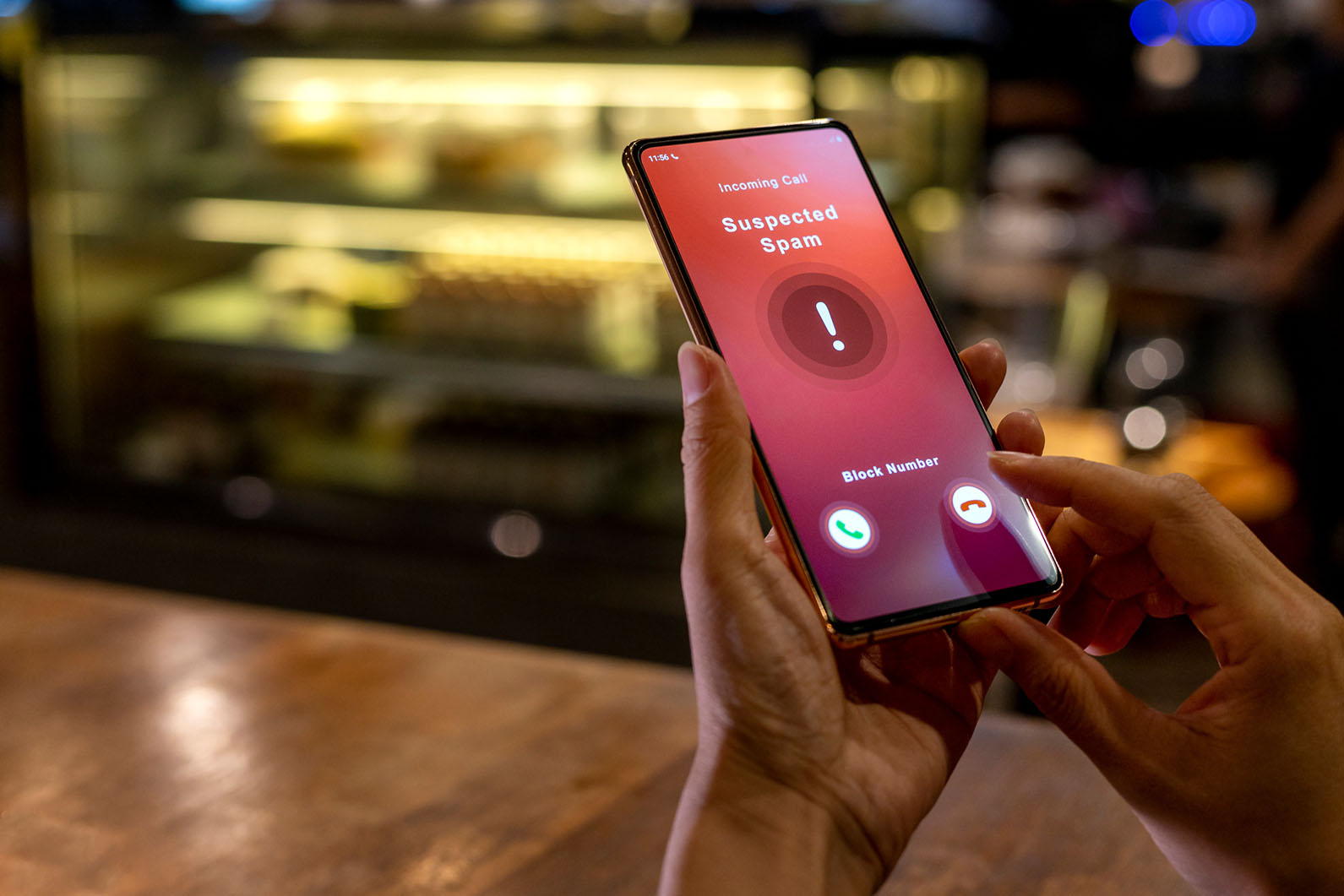Protecting Yourself and Your Loved Ones from Scams and Fraud

If you’ve been following the news, scams and fraud are seemingly everywhere in our world. Whether over the phone, online, or even in the mail, it seems like there is a new trick to learn every day with regards to fraudsters, and it is important to stay informed about the latest cons to protect yourself and your family.
In this article, we sat down with Rachel Nguyen, American Heritage Credit Union’s Vice President of Compliance & Risk, to evaluate current fraud trends and learn how to avoid becoming a victim. Continue reading and share this article with your loved ones to best protect your information.
What are some of the newest scams that you see members facing today?
For as long as there has been money, there has been fraud. Identity theft, synthetic identity fraud, and phishing scams are some biggest fraud trends we have seen lately. None of these types of fraud are new but are now more prevalent because of increased opportunity.
For example, synthetic identity fraud was less prevalent many years ago because it was harder to steal personal information and create a completely new identity, but new technology like deepfakes make it easier. Synthetic identity fraud is a type of financial crime in which a fraudster creates a fake identity using a combination of real and fake personal information. This fake identity is then used to apply for credit, open bank accounts, or make purchases, among other things.
The average person is not keeping up with evolving technologies. Nowadays, people are less cautious and believe that everyone they’re talking to on the computer is legitimate. When social media sites first came to be, people didn’t accept every friend request, but now people let strangers into their circle to increase their number of friends, followers, or likes. There are now more services on social media sites, including house or car rentals and the marketplace, and these should be carefully vetted, especially when money is involved.
Technology is a good thing but can be a means for bad things to happen. There are also deceptive methods, like advertisements or fake reviews that make everything from apps to products look safer.
Unfortunately, research shows that elderly consumers are frequently targeted because they tend to rely on personal communications with their various financial institutions, and when an urgent personal message arrives from a seemingly-familiar institution, they can feel overwhelmed. They tend to trust in what they see online or hear on the phone, especially from people who claim certain positions or status.
Phishing scams are attempts by scammers to trick you into giving them personal information, such as your full credit or debit card data, Online Teller login credentials, or full bank account information, by disguising themselves as legitimate company or individual. For example, fraudster may spoof (deliberately falsify the information transmitted to your caller ID display to disguise their identity) the phone number of legitimate bank, credit union, or company so it appears that the incoming call is coming from your financial institution or a government agency that you know and trust.
Why do you believe there has been such a rise in fraud and scams?
According to research, though fraud has been an existing problem, some of these factors may have contributed to the recent rise of fraud and scams:
- Global COVID-19 crisis – opportunistic hackers have taken advantage of the chaotic, global crisis to commit even more fraudulent activity.
- A changing e-commerce landscape – more retail purchases shifting online. Card-not-present (CNP) transactions have increased dramatically in recent years, with these transactions accounting for 27% of all debit transactions in 2019 and increasing 10 times faster than card-present transactions.
- The advent of new marketplace platforms – from social networks and dating apps to food delivery, alternative transportation, and vacation rentals, digital channels have revolutionized almost every industry.
- Payments moving online – in addition to consumers transacting more in online marketplaces, they are also using peer-to-peer payment (P2P) and eWallet apps more often. These apps are most popular in Europe and Asia but are becoming increasingly popular in the U.S.
- Increasingly digital banking services – today’s consumers demand more online and mobile services from their financial institutions. As a result, legacy banks are going digital. They are doing more account onboarding and transaction approvals online and deemphasizing in-person transactions, which makes it harder to verify identities.
- New consumer expectations – today’s consumers also expect their data to be secure, yet they will abandon any transaction that takes too long, requires too much data, or is too complex.
- More sophisticated fraud tactics – Due to an increasing number of data breaches over recent years, fraudsters can more easily access PII (personally identifiable information) and use it against consumers.
- Unclear legal jurisdiction of cross-border fraud – global commerce gives today’s online retailers and marketplaces an opportunity to reach even more customers.
- Technological advancements – fraud has also accelerated and grown even more sophisticated due to the rise of eCommerce, mobile payments, and computing power. Many of the same technologies that companies rely on to innovate and rapidly introduce new products and services are also being adopted by fraudsters.
Why is it important for people to take precautions to protect their own accounts, in addition to what their financial institution provides?
Some people do not protect their own information because they feel that the bank is responsible for doing that, and that insurance protects them with zero liability, so they become careless.
When it comes to protecting your information, think beyond the financial losses. While insurance and institutional protections can help, they can never take back your time, resources, dignity, identity, or safety. You will have to fight your own battles to prove that you are not the one who opened an account, applied for a loan, or even committed a crime.
Identity theft will continue to follow you on your record for years after the theft. You will have to constantly freeze or unfreeze your credit to apply for future loans. Make sure to protect and check children’s accounts as well, as child identity theft can go undetected until late in the child’s life.
If your loved one and other relatives are on social media, encourage them to set their pages and profiles to private. This will make it harder for scammers to collect the information they need to make a scam believable.
Your information is the gateway to your financial institutions, medical records, credit score and other important personal records. There is nothing more important than keeping your personal information secure so that you can prevent identity theft.
What should a member do if they suspect they have been a victim of fraud or a scam?
The very first action to take is to call affected financial institutions right away. The sooner you call to explain the situation, the more likely something could be stopped in transit.
However, there are some things that cannot be taken back, in which case the money is lost for good. The most at-risk transfers are wires, peer-to-peer networks that tap directly into your bank account or ATM card, or untraceable methods like gift cards. There is a gray area between who is responsible in these cases because you willingly gave the information away.
Additional steps to take:
- File a report with your local police precinct or your state’s attorney general.
- File a complaint with the Federal Communications Commission (FCC) or Federal Trade Commission (FTC).
- Contact close any impacted accounts at your financial institution.
- Contact one of the three credit reporting agencies to place an extended fraud warning or credit freeze.
How can we better educate our loved ones about the dangers of spoofed phone numbers or impersonators?
Protect loved ones by putting reminders in high-traffic areas like on the fridge or by the computer. Make sure they let you know if they are contacted by anyone requesting personal information or claiming they owe a debt. Show them news stories about real life examples so they have a better idea of how the scam works and know some of the common red flags.
These red flags include:
- Leveraging artificial (or real) familiarity – fraudsters will leverage relationships to build your trust and confidence in them and ask for help in some way. This could include asking for your personal information – which they then use for fraudulent purposes – or requesting that you initiate a payment to them.
- Playing on emotions – a fraudster will use both positive and negative emotions to cause you to act a certain way. For example, a fraudster may spoof your credit union’s or bank’s phone number to call you and use scare tactics (“Your card has been used for certain purchases” or “Your account was hacked”). This fear often causes people to act quickly without evaluating the legitimacy of the situation.
- Asking for immediate payment – legitimate institutions such as credit card companies or the IRS do not threaten or demand immediate payment for owed funds. If you truly owe the money, wait a day or two. The proper channels will come to you and work to establish a repayment plan.
- Claiming to be a family member in crisis – fraudsters may pose as a family member in crisis and demand funds right away.
- Come up with a family password and share it with your family. If they ever are in a crisis, they can use the password to let their family know the situation is real. Many scam artists will hang up if they’re asked “What’s the family password?” during the call.
- Brainstorm questions your loved one can ask the caller that only the family member in question would know the answer to. Be sure to choose a question where the answer is not easy to find using social media or internet searches.
- Suggest that your loved one hang up and call back using their grandchild’s contact information saved on their phone rather than the number that called them.
- Remind your loved one to stay calm. If they are in a panic, they are more likely to miss giveaways like the caller having an unfamiliar voice or accent or calling them “grandma” or “grandpa” instead of their typical “granny” or “poppy.”
Additional FTC safety tips include:
- Don't answer calls from unknown numbers. If you answer, hang up immediately.
- If you answer the phone and the caller – or a recording – asks you to hit a button to stop getting the calls, just hang up. Scammers often use this trick to identify potential targets.
- Do not respond to any questions, especially those that can be answered with "Yes" or "No."
- Never give out personal information such as account numbers, Social Security numbers, mother's maiden names, passwords, or other identifying information.
- If you get an inquiry from someone who says they represent a company or a government agency, hang up and call the phone number on your account statement or on the company's or government agency's website to verify the authenticity of the request. You will usually get a written statement in the mail before you get a phone call from a legitimate source, particularly if the caller is asking for a payment.

